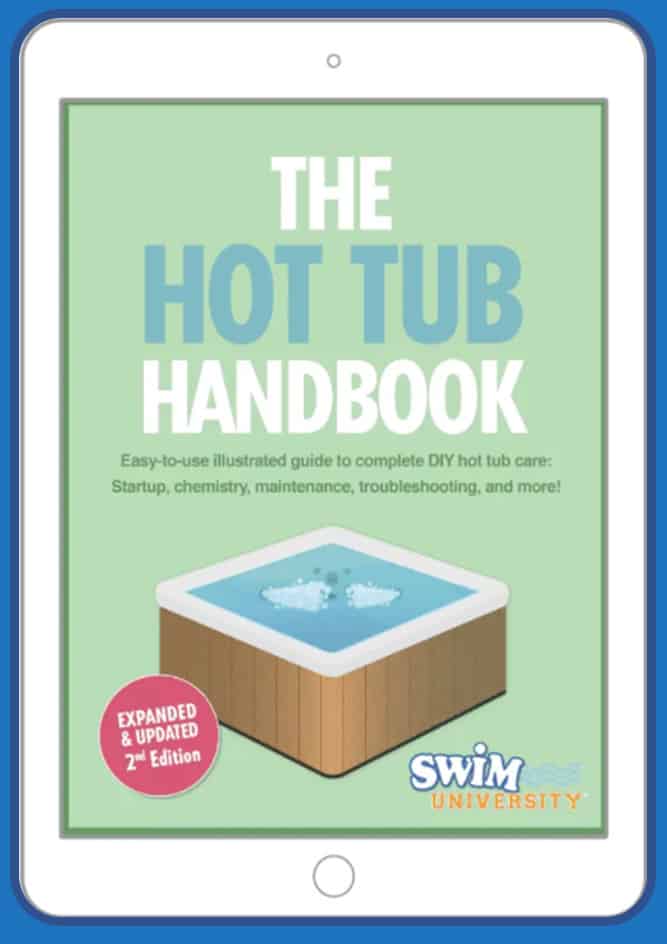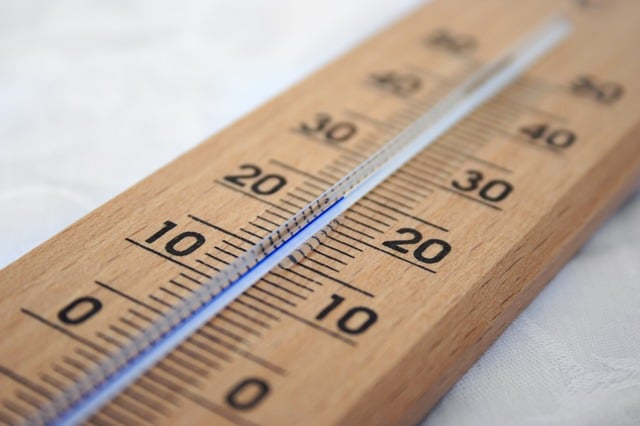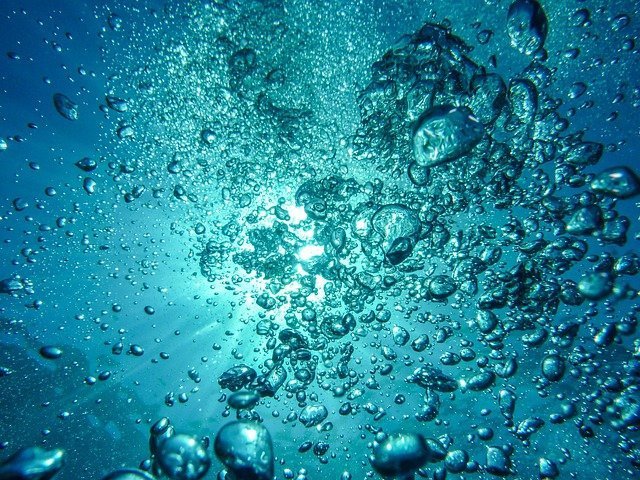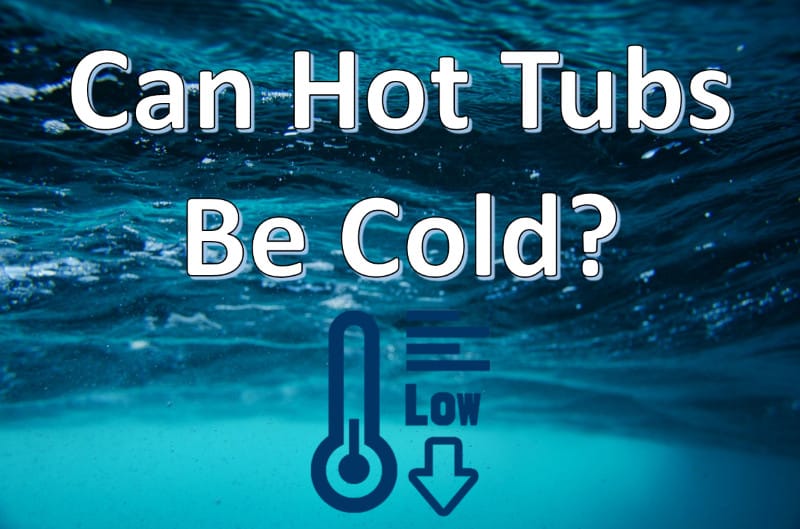Can hot tubs be cold?
Yes, they can! Hot tubs are designed to maintain a certain temperature, and when that degree of hot or cold is reached, the heater will turn off. There could be a variety of benefits associated with having an ambiently cooler hot tub. Some benefits include relieving stress, anxiety, depression, and muscle soreness.
Stop wasting time and money with hot tub maintenance and confusing water chemistry! The Hot Tub Handbook and Video Course will help keep your hot tub balanced, sanitized, and crystal clear all the time.
Check out my list of high-quality hot tub products to help keep your hot tub clean and running great all year long!
I recommend a digital floating thermometer for your hot tub for more accurate temperature readings.
A few months ago, a friend wanted to know more about cold showers and their benefits. I thought maybe a cold hot tub would also be a neat idea, so I researched it. This is what I found.
Hot tubs are usually hot. But what if they were cold? That may seem like an oxymoron, but there is a lot to be said for the benefits of cold water therapy in some circumstances!
Some other benefits include less time needed heating up in summer months, soothes sunburns better than warm water, feels refreshing on hotter days because cool air allows body temp regulation without overheating, etc.
If you’re looking to protect your hot tub in cold or hot weather, check out our article on the best hot tub covers.
Let’s find out more about cold hot tubs.
Let’s get started!
Can You Keep A Hot Tub Cold In Summer?
Absolutely! A cold hot tub will help cool you down, provide therapy for your skin due to its cooler temperature, and even relieve some conditions such as depression.
One way of keeping a hot tub cold is by purchasing one with an automatic thermostat, which regulates the water’s temperature when it reaches a certain degree of warmth or heat.
When this happens, the heater will turn off until there needs to be more heating again. The other option is to use ice to keep it colder than usual- though not necessary if you live somewhere where the ambient air stays chilly year-round like Alaska.
5 Benefits Of A Cold Hot Tub
Here are three significant benefits of a cold hot tub:
A Cold Hot Tub Is An Excellent Way To Stay Relaxed And Rejuvenated
A cold hot tub is an excellent way to stay relaxed and rejuvenated. This is because cold water can reduce pain, decrease inflammation and even relieve some conditions such as depression.
Why does cold water help you relax? A cold hot tub can stimulate the release of endorphins, which naturally help you feel good. Soaking in water is also a great way to reduce your stress levels and improve your sleep quality (which will allow you to rejuvenate).
Why do I feel better after a cold shower? Most of us know that a cold shower can be refreshing. This is because the sudden temperature change helps release endorphins in your body, which are natural feel-good hormones.
If you’re feeling down and need an energy boost, try taking a cold bath! The same thing can be said about hot tubs.
Coldwater Therapy Can Help With Many Ailments, Such As Muscle Cramps, Headaches, Arthritis
Coldwater therapy can help with muscle cramps because cold water reduces the muscle’s temperature, which can help relax your muscles and relieve cramps. Cold showers or baths have been known to also reduce soreness by reducing inflammation in joints.
Cold therapy has even been shown as an effective treatment for headaches and arthritis pain!
Coldwater can relieve headaches because it can constrict blood vessels in the body, reducing pain. As for arthritis, cold water has a similar effect as ice packs because it reduces inflammation and pain by decreasing joint swelling.
Relieve Stress, Anxiety, Depression, and Insomnia
Coldwater can relieve stress because there is a drop in blood pressure and heart rate. This can also help with anxiety because cold water can reduce the body’s cortisol level, which is associated with stress and related disorders like depression.
Another benefit from using cold therapy for these conditions is that it can be used as an effective treatment for insomnia; studies have shown that it helps relax muscles to improve sleep quality.
So if you’re feeling stressed or anxious, depressed, or tired during the day, give coldwater therapy a try with your hot tub!
If you’re looking for a great spa robe when going out to the hot tub, I recommend this robe from Alexander Del Rossa.
If you’re looking for some great slippers to wear out to your spa, check out these memory foam slippers.

Stop wasting time and money with hot tub maintenance and confusing water chemistry! Get Instant access to this easy-to-use book and video course so you can spend less time cleaning and more time soaking.
Learn MoreWhat Is The Lowest Temperature For A Hot Tub?
The lowest temperature for a hot tub is typically around 50 degrees Fahrenheit. However, this can depend on the type of hot tub you have and the water chemistry.
A cold hot tub can be maintained at these low temperatures through a few different methods:
Traditionally, ice cubes will need to be added to the mix to lower the water temperature in your hot tub. This process is called “chilling” or “cold shocking.” The amount of time needed to cool down a hot tub can vary, but it can take days.
Another method is to use a “chill out” (a device that chills your water quickly) or an ice machine that circulates the cold into the hot tub and cools down its temperature.
If you’re looking for cold therapy – but want something warmer – how about taking some cool showers or dipping into an ice bath? These will give you similar benefits without having to use up all your energy heating the water! Just make sure not to stay in too long! You don’t want to get hypothermia from being submerged in cold water.

Is 40 Degrees Hot Enough For A Hot Tub?
40 degrees is not hot enough for a hot tub. A hot tub should be at least 50 degrees Fahrenheit. If the water starts to get to the freezing mark (32 degrees Fahrenheit), ice may begin to form in the water, ultimately damaging the pumps, heater, plumbing, jets, and filters.
Check out our full article on average temperatures for hot tubs for more information.
Can A Hot Tub Also Be A Pool?
It can be both a hot tub and a pool. Some people like to use their hot tubs as pools because they are not the best swimmers or don’t have access to an outdoor swimming pool. Typically pools are larger, and the water temperatures are colder than hot tubs. However, if your hot tub is big enough, you can use it as a pool.
What’s the difference between a pool and a hot tub?
One significant difference is that people can typically swim in a pool, but not usually in a hot tub. It may be more challenging to swim in a hot tub because the water is generally hotter (around 100 degrees Fahrenheit) and not as deep.
The significant difference between a pool and a hot tub is that pools are typically larger than hot tubs, making them more accessible to swim in. They also have colder temperatures of around 78-82 degrees Fahrenheit while most hot tubs maintain temperatures from about 94-102 degrees Fahrenheit.
For more information on overheating hot tubs, check out our article on the subject for more information.
Do Hot Tubs Always Have To Be Hot?
Hot tubs don’t always need to be hot, but it depends on the manufacturer. If you’re looking for a colder experience, there are warmer hot tubs that can be turned down to accommodate a less intense temperature.
Hot tub manufacturers often offer both warm and cold versions of the same model so that you can choose which one best suits your needs.
In general, hot water alleviates inflammation and pain, while cold water helps relieve swellings and stiffness in joints caused by arthritis.
It also reduces blood pressure which can help with heart disease risk factors. Colder temperatures are perfect for people who suffer from chronic health conditions like psoriasis and eczema because they may not tolerate higher temperature waters that would aggravate their condition.
Check out our full article on using a hot tub with high blood pressure for more information.

Good Overall Maintenance
Monitoring the health of your hot tub can often be challenging if you are not testing the water on a regular basis. This can also be a problem if you go on holiday or you are unable to take care of your hot tub due to mobility issues.
The pHin Smart Water Care Monitor for pools, hot tubs, and inflatable spas continuously tests the water and alerts you when to add chemicals with the integrated mobile app.
This water care monitor also takes constant readings of the temperature inside your hot tub. This will give you peace of mind while away from your spa.
The mobile app will inform you when to add chemicals such as chlorine, and how much chemical is recommended. This is done by entering your hot tub or pool’s unique dimensions.
Simply scan the bar code of any chemical brand and the pHin app will calculate how much chemical is to be added to the water. Most products and brands are recognized by the application.
The pHin device will sample water more than 1000 times per week to give you an accurate reading compared to using test strips.
The pHin device works with different water types including chlorine, bromine, and saltwater hot tubs, swim spas, inflatable hot tubs, and pools.
This unique device comes with a lifetime warranty to ensure your water remains clear and ready for you to use at all times.
Check out our article on how to fix cloudy hot tub water for more information on spa water maintenance.
Hot Tubs With Built-in Cooler
Hot tubs with built-in coolers are popular with those looking to swim in cold water.
What sets them apart from regular hot tubs is that they have a built-in refrigeration unit that cools the water and lowers its temperature without using chemical agents or salt. This means there’s no need for maintenance costs related to chemicals and less of a chance for skin irritation, an issue often associated with high chlorine levels found in other types of pool/spa systems.
Often the hot tub seats with jets are specifically designed for cooling down your body when you get out of the tub after taking a dip.
Hot Springs hot tubs make the best cold hot tubs with their integrated CoolZone hot tub cooling system.
How Does a Hot Tub Chiller Work?
A hot tub chiller will help you enjoy the dips in your backyard oasis even more by ensuring that water is always at a refreshing temperature. They work just like air conditioners, but instead of using vents, they use plumbing to pump chilled water through your hot tub for optimum cooling! Most chillers also come equipped with external circulation, which allows them to cool every last drop of pool liquid efficiently, so it’s completely free from any refrigerant residues.
A hot tub is designed to heat up, and cooling down is nearly impossible when it’s summer. Sure, you can set the temperature to a lower setting, but if it’s brutally hot outside, then that doesn’t work either! A Hot Tub Chiller will slowly cool your water over time by about 2 degrees per hour, depending on how hot it is outside.
Why Cold Water Hot Tub Therapy Is Popular
Coldwater therapy is a water-based treatment consisting of using water around 59° to cold under normal conditions. Cold temperatures are used to reduce body temperature, stimulate blood vessel dilatation and change tissues for recovery after exercise or injury. The therapy can reduce pain, inflammation, and spasm while also increasing the range of motion – all without the risk associated with surgery and drugs.
As far as the benefits of cold tubs go, it’s essential to keep in mind that different people have their preferences and can benefit from various temperatures. For example, some like it hot (hot springs), others prefer warm water (jacuzzi), while some want soothingly cool baths or pools for therapeutic reasons (refrigerated).
Experts believe that the cold water in a hot tub can have several health benefits. For instance, acute exposure to icy water is thought to stimulate your immune system and improve your body’s ability to fight off illnesses.
Swimming in frigid water is not a cure for any mental health condition. But certain case studies suggest that open water swimming has helped alleviate symptoms of depression and anxiety in some people.
Though researchers continue to debate the exact details, cold water immersion after exercise appears to provide some benefits.
How Long Should You Use A Cold Hot Tub?
Cold hot tubs work best for treating chronic pain because they can help alleviate soreness faster. Coldwater also offers a convenient way to cool down after exercise or an intense workout session. However, cold hot tub sessions should be limited in duration and frequency – it’s not good to spend too much time exposed to cold temperatures! The best amount of time is between 10 and 20 minutes.
How Long Does It Take To Cool Down My Hot Tub?
It can take up to two days to cool down a hot tub if the heater is turned off. If you’re using a hot tub chilling system, it will reduce the temperature by 2 degrees every hour. Adding cold water and ice will help speed up this process.
Check out our full article on using a hot tub in the summer for more information.
Can Hot Tubs Be Cold: Conclusion

In conclusion, cold hot tubs can benefit those who have chronic pain or need to cool down after a workout. It’s not good to spend too much time exposed to such low temperatures, however, so limit your sessions accordingly.
The best amount of time is between ten and twenty minutes. Using a hot tub chilling system will reduce the temperature by two degrees every hour. Adding extra ice and cold water can help speed up this process if desired.
I hope you found this article helpful on cold hot tubs.
Thanks for visiting spatoolkit.com
James Brockbank

Stop wasting time and money with hot tub maintenance and confusing water chemistry! Get Instant access to this easy-to-use book and video course so you can spend less time cleaning and more time soaking.
Learn More



